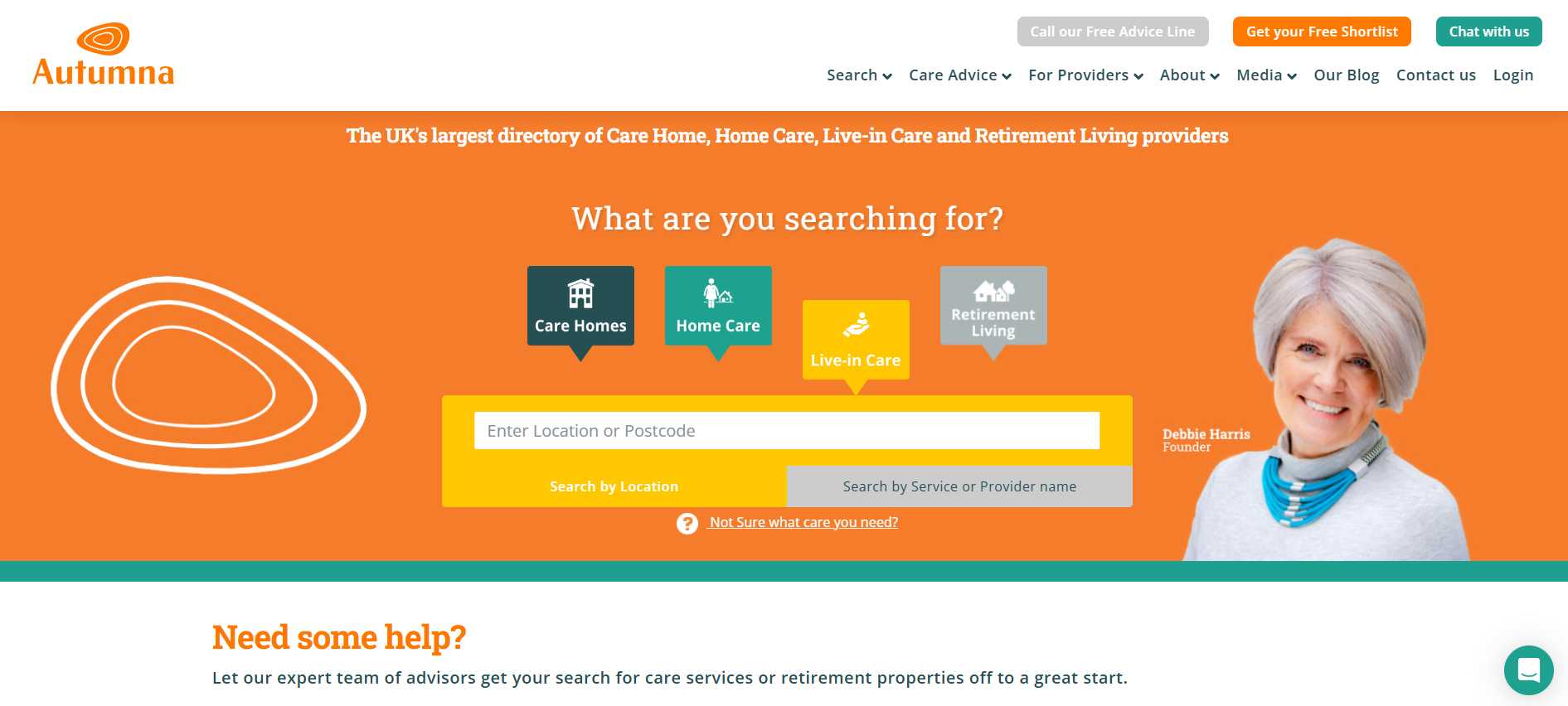Posted by Janine Griffiths
What is live in home care?

Imagine waking up in your own bed, surrounded by familiar comforts, knowing that a dedicated caregiver is there to support you whenever you need.
For many, staying at home as they age or recover from illness is a top priority—but balancing independence with the right level of care can be challenging. This is where live-in home care comes in.
But what is live-in home care, exactly? And how does it differ from other care options?
Whether you're exploring care for yourself or a loved one, understanding live in home care can help you make an informed decision about the best way to maintain quality of life at home. Let’s break it down.
What is live in home care and how does it work?
When everyday tasks become challenging, but moving into a care home isn’t the right choice, live-in home care offers a solution. A professional caregiver moves into the home, providing round-the-clock support while allowing individuals to remain in familiar surroundings.
Live-in caregivers assist with a range of daily activities, including personal care, meal preparation, medication management, and household tasks. They also offer companionship, emotional support, and reassurance for both the individual receiving care and their loved ones.
Unlike hourly home care, where caregivers visit for short periods, live-in care ensures continuous support, tailored to specific needs. This makes it an ideal choice for those requiring consistent assistance while maintaining as much independence as possible.
When might live-in home care be right for you?
Deciding on the best care option can be overwhelming, especially when balancing independence with the need for support. If you’ve asked yourself the question ‘what is live-in home care?’ and whether it’s the right choice, consider your daily challenges and overall wellbeing.
Live-in care may be ideal if you or a loved one struggle with mobility, need help managing a medical condition, or require assistance with personal care and household tasks. It’s particularly beneficial for those with dementia, individuals recovering from surgery, or anyone who feels isolated and would benefit from companionship.
Unlike residential care, live-in home care allows you to stay in a familiar environment while receiving personalised, one-on-one support. If maintaining comfort, routine, and independence at home is a priority, this type of care could be the perfect solution.
Pros and Cons of Live-in Home Care
So now that we’ve answered the key question ‘what is live in home care?’, you may be wondering what the pros and cons of it are. Understanding the positive and negative impact of live in home care is important in helping you to make an informed decision.
Advantages of live in home care
Live-in home care offers a range of significant benefits that can make it an ideal choice for those seeking care in the comfort of their own home. Below are some of the main benefits:
Comfort and familiarity
One of the most notable advantages is the comfort of staying at home. Being in familiar surroundings helps maintain a sense of normalcy and emotional stability, which can greatly improve the overall wellbeing of the individual receiving care. The home environment offers a sense of security and peace, reducing feelings of stress or anxiety that might arise from relocating to a care facility. For many, understanding what live-in home care is means recognising that it allows them to remain in a place they know and love while still receiving the support they need.
One on one support
Unlike other care options where individuals may receive intermittent visits from different caregivers, live-in home care ensures that the same person is consistently present to address both medical and personal needs. This personalised attention allows caregivers to build a deep understanding of the individual’s preferences, routines, and health needs, leading to a higher quality of care. With live-in care, individuals receive undivided attention, which helps create a stronger, more trusting relationship with their caregiver.
Maintain independence
Live-in home care also offers the unique advantage of allowing individuals to maintain their independence. Being able to live in one’s own home means that daily routines—such as meal preparation, housekeeping, and social interactions—can continue with minimal disruption. This preservation of routine is particularly important for those with dementia or cognitive impairments, as maintaining familiarity and consistency is key to improving quality of life.
Companionship
Many people, particularly seniors, experience feelings of loneliness or isolation. A live-in caregiver not only provides practical assistance but also offers emotional support and social interaction. Whether it's chatting, participating in hobbies, or simply being a reassuring presence, the caregiver helps combat feelings of loneliness, which can have a positive impact on mental health.
Flexibility and adaptability
As care needs change, the caregiver can adjust their support to meet evolving health conditions. Whether the person needs more help with mobility, personal care, or managing medications, live-in caregivers can offer tailored care that evolves with the individual's specific requirements. This flexibility ensures that the individual can continue to receive the necessary care without the disruption of frequent changes in caregivers or environments.
Cons of live in home care
While live-in home care offers numerous benefits, there are also some potential downsides that should be carefully considered before making a decision.
Cost of live in home care
Understanding what live in home care is also means considering whether the cost aligns with both the level of care needed and the available financial resources. While live-in care can sometimes be more affordable than residential care homes, it still represents a significant financial commitment. The cost of hiring a live-in caregiver can be higher than other forms of home care because it involves 24/7 support. For many individuals and families, this expense may require careful budgeting or financial planning to ensure that it is a sustainable option over the long term.
Impact on privacy
Having a caregiver living in the home means sharing personal space on a constant basis, which can be difficult for those who are used to living alone or value their privacy. The caregiver will need access to various areas of the home, and in some cases, their presence may feel intrusive. For individuals who are highly independent or prefer solitude, this shift may take time to adjust to and could cause some discomfort.
Space requirements
Live-in caregivers need their own private room within the home, which may not be feasible in smaller living spaces. For individuals living in a compact apartment or a home without an extra bedroom, finding room for a live-in caregiver may present a logistical challenge. This limitation can make live-in care less practical for some households, especially if space is already at a premium.
Caregiver breaks
While live-in caregivers provide constant support, they are human beings who require time off for rest and personal needs. This means that there may be periods when an alternative caregiver or support system is required. While many caregivers work in shifts or receive respite care, the need for time off could disrupt the continuity of care or cause temporary gaps in support. This may require coordination with agencies or family members to ensure that care remains consistent during these times.
Caregiver burnout
Although live-in caregivers are dedicated and skilled, providing 24/7 care can be physically and emotionally demanding. It is important for both the caregiver and the person receiving care to ensure that proper boundaries and support systems are in place to prevent caregiver exhaustion or burnout.
Considering these potential drawbacks is important in determining if live-in home care is the right fit for an individual's needs and circumstances. By addressing concerns such as cost, space, and privacy, it is possible to make an informed choice about whether this option aligns with their care requirements.
How to arrange live-in home care
There are many questions that people have when it comes to live in home care.
The most common ones are: ‘what is live in home care and how can I arrange it? How much does it cost? Where can I get more information?'
While the definition of live in home care has been defined above, in this section we will be focussing on where to start when it comes to arranging live in home care.
The process can feel overwhelming at first, but by following the steps below, you can find a caregiver who meets your needs and ensures a smooth transition to receiving care at home.
Assess your needs
The first step is to assess the level of care required. Consider factors such as medical needs, mobility support, personal care, and companionship. Some individuals may need assistance with daily tasks like cooking and cleaning, while others require more specialised care, such as support for dementia or complex medical conditions. Understanding the full scope of needs will help determine the type of caregiver best suited for the role.
Choose between an agency or private hire
Live-in caregivers can be hired through a care agency or directly as an independent caregiver. Agencies provide a structured service, handling recruitment, vetting, training, and backup support if a caregiver is unavailable. This can offer peace of mind and simplify the process. Alternatively, hiring privately gives you more control over selecting a caregiver but also comes with added responsibilities, such as managing contracts, payroll, and ensuring legal compliance. Either route can work well depending on your preferences and level of involvement.
Find the right caregiver
Whether working with an agency or hiring privately, it’s important to find a caregiver who is not only qualified but also a good personality fit. Conduct interviews, check references, and discuss expectations openly. A strong caregiver-client relationship is key to ensuring a positive experience for both parties. Since live in home care ultimately comes down to providing personalised, around-the-clock support, choosing the right person is one of the most crucial steps in the process.
Prepare the home
Before a live-in caregiver moves in, some adjustments may be necessary to create a comfortable and functional living environment. The caregiver will need their own private space, and any necessary safety modifications—such as grab rails or stairlifts—should be put in place to accommodate the needs of you or a loved one as well. Clear communication about house rules, daily routines, and expectations will also help establish a smooth working dynamic from the start.
Review care arrangements regularly
Once live-in care is in place, regular reviews are essential to ensure that the arrangement continues to meet the needs of the individual receiving care. Care plans should be flexible and adjusted as circumstances change. Open communication with the caregiver, family members, and, if applicable, the agency, will help address any concerns and ensure ongoing high-quality care.
A well-planned approach makes all the difference in ensuring that live-in home care delivers the benefits of comfort, independence, and continuity of care.
Looking for a care provider?
If you are searching for a live in carer, or any type of care provision, Autumna can make it easy to find the help you need.
All you need to do is head over to our homepage and select the 'Live in Care' button above the search bar.
Next, enter your preferred area and our system will then generate a list of live-in providers in that location.

You can also use our shortlisting tool and answer a few questions in order to receive a more personalised list of providers. Alternatively, speak to one of our knowledgeable and friendly live-in care experts by calling 01892 335 330.
Receive a Free Live-In Care Shortlist!
Let our expert team of advisers get your search off to a great start.
Tell us a little about your needs and we'll send you a bespoke shortlist of live-in care providers! Click the button below to begin, it takes just a few minutes.
Other articles to read
From the blog

Older Persons Care Advice
Ultimate guide to care homes in Norwich
April 23rd, 2025
Discover the best care homes in Norwich—explore lifestyle-focused options, top-rated services, and how to choose the right home with confidence.

Older Persons Care Advice
How to find an adult day care centre near you
April 22nd, 2025
Looking for an adult day care centre near you? Discover how to find safe, joyful care for your loved one—and support for yourself—on Autumna.

Older Persons Care Advice
How to shortlist care homes in Exeter
April 17th, 2025
Need help shortlisting care homes in Exeter? Learn how to filter options with confidence, compare homes, and find the best fit with Autumna’s free tools.
Frequently Asked Questions
Live-in home care provides 24/7 support from a dedicated caregiver who moves into the home. They assist with daily tasks, personal care, companionship, and medical needs, allowing individuals to stay in familiar surroundings while receiving tailored support.
Unlike hourly home care, where caregivers visit for set periods, live-in care ensures round-the-clock assistance. This provides greater consistency, a stronger caregiver-client bond, and a more personalised approach to care.
No! Live-in care is suitable for anyone who needs ongoing support, including individuals with disabilities, those recovering from surgery, or anyone requiring help with daily tasks while remaining at home.






